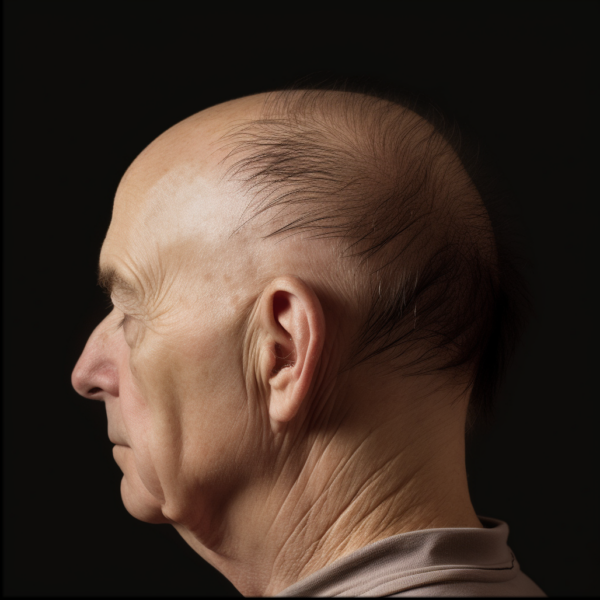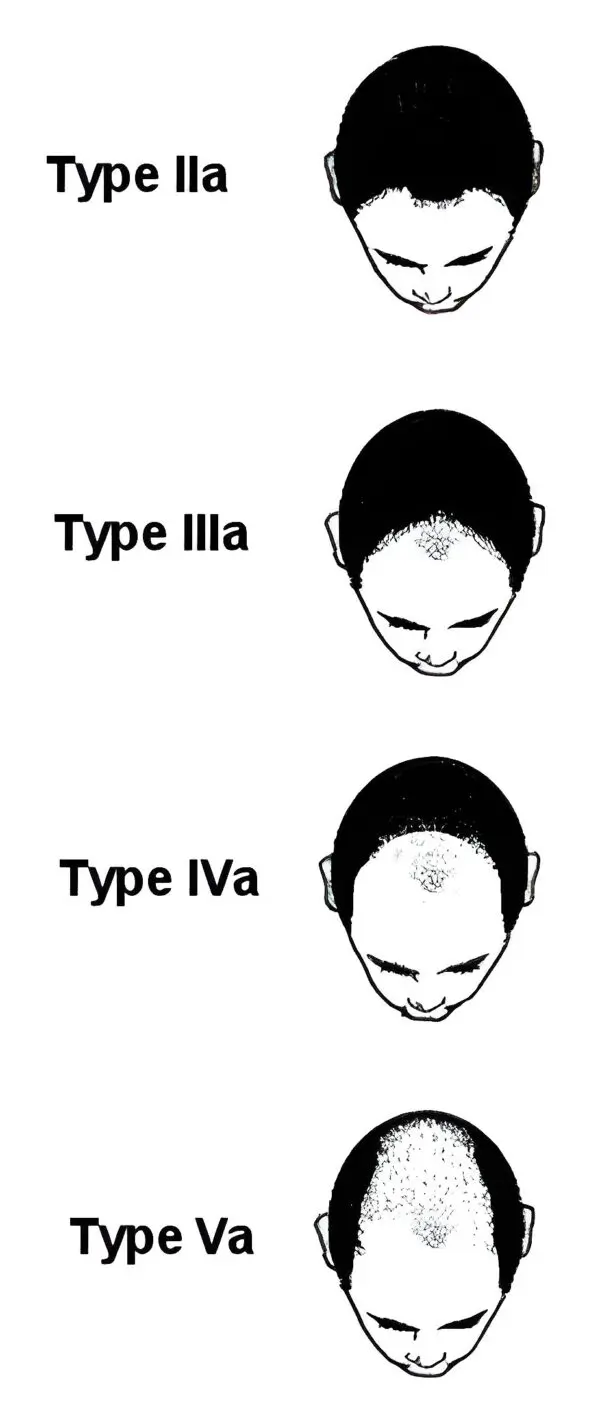Androgenetic alopecia (AGA) is the most common form of hair loss in both men and women. While genetic predisposition and hormonal factors have long been recognized as central to the development of AGA, emerging evidence suggests that nutritional factors, particularly iron status as measured by serum ferritin levels, may also play a role. This article reviews the current understanding of AGA and explores the potential relationship between serum ferritin/iron levels and hair loss, discussing the underlying mechanisms and clinical implications.
Understanding Androgenetic Alopecia: Androgenetic alopecia is characterized by a patterned loss of hair, typically involving thinning on the crown and frontal scalp in men, and diffuse thinning over the mid-scalp in women. The condition is strongly influenced by genetic predisposition and is associated with the androgen hormone dihydrotestosterone (DHT), which binds to receptors in the hair follicle, leading to miniaturization and eventual loss of the hair shaft.
The pathogenesis of AGA is multifactorial. Androgens, particularly DHT, have a key role in transforming terminal hair follicles into miniaturized vellus-like hairs. This process is largely genetically mediated, and the sensitivity of hair follicles to DHT is determined by androgen receptor expression and other local factors. While the role of hormones and genetics is well-established, recent studies have proposed that other systemic factors, such as nutritional status, may modify the expression or severity of hair loss in individuals with a genetic predisposition.
The Role of Serum Ferritin and Iron in the Body: Iron is a vital mineral involved in various physiological processes, including oxygen transport, energy metabolism, and DNA synthesis. Serum ferritin is the primary intracellular protein that stores iron and releases it in a controlled fashion. Thus, serum ferritin levels are often used as a surrogate marker for the body’s iron stores.
Importance of Iron for Hair Follicle Function: Hair follicles are among the most rapidly dividing cells in the human body, requiring a robust supply of nutrients, including iron. Iron is a vital component for the proliferation and differentiation of cells, processes that are fundamental to the hair cycle. An adequate iron supply supports the anagen phase (active hair growth), whereas iron deficiency can disrupt this cycle, potentially leading to premature transition to the telogen phase (resting phase), and subsequent hair shedding.
Iron Deficiency and Hair Loss: Iron deficiency, even in the absence of anemia, has been implicated in hair loss. Several studies have investigated the link between low serum ferritin levels and diffuse hair shedding, especially in women. Although the relationship between iron deficiency and AGA is not as clearly defined as it is with other forms of hair loss (such as telogen effluvium), some evidence suggests that suboptimal iron stores may exacerbate hair loss in individuals predisposed to AGA.
Proposed Mechanisms: There are several possible mechanisms that have been suggested might underlie the apparent link between androgenetic alopecia and low iron:
Hair Cycle Disruption: Iron deficiency may impair the metabolic processes required for the maintenance of the anagen hair growth phase. Reduced iron levels can compromise the energy production necessary for rapidly dividing hair follicle cells, leading to a shortened anagen phase and a shift towards the telogen phase.Oxidative Stress: Iron plays a role in the body’s oxidative balance. Deficient iron levels can contribute to an increased susceptibility to oxidative stress, which in turn may damage hair follicle cells. Oxidative damage has been suggested as a contributing factor in the pathogenesis of AGA, potentially linking iron deficiency with an increased rate of hair follicle miniaturization.Immune Modulation: Iron is involved in various immune responses. An imbalance in iron homeostasis can lead to an altered immune response, which may indirectly affect hair follicle health. Inflammatory processes have been implicated in various types of alopecia, and an inadequate iron status might influence these pathways. Inflammation can be seen in AGA affected hair follicles in some people. Clinical Studies and Evidence: Several clinical studies have evaluated the association between serum ferritin levels and hair loss. While the findings have occasionally been contradictory, there is a growing body of literature supporting the notion that low serum ferritin levels are associated with increased hair shedding and may worsen the presentation of hair loss in patients with AGA.
Observational Studies: In several observational studies, individuals with hair loss – especially women presenting with diffuse hair thinning – often exhibit lower serum ferritin levels compared to controls without hair loss. These studies highlight the importance of evaluating iron status as part of the diagnostic workup for patients with hair loss complaints. Quite recently, there have also been studies on men that have shown at least a subset of men with AGA also have low serum ferritin levels.
Intervention Studies: Intervention studies have provided further insights by assessing the effect of iron supplementation in individuals with low serum ferritin levels. In some cases, iron supplementation led to improvements in hair density and a reduction in hair shedding, suggesting that correcting iron deficiency might benefit hair follicle function. However, the response to supplementation can vary, and further research is needed to establish standardized treatment protocols. It should be noted that excessive iron intake is toxic as the body can only process so much each day. Consequently, careful dosing is needed with iron supplements.
Considerations in Androgenetic Alopecia: While most of the research linking iron deficiency to hair loss focuses on conditions such as telogen effluvium, a subset of patients with AGA may also present with low serum ferritin levels. In these cases, the iron deficiency may act as an exacerbating factor, accelerating the hair cycle disruption already present due to hormonal influences. Consequently, addressing iron deficiency could potentially slow the progression of hair loss or improve the efficacy of other therapeutic interventions aimed at mitigating the effects of DHT on hair follicles.
Significance for Clinical Practice: The potential relationship between serum ferritin levels and hair loss has important clinical implications. For clinicians managing patients with AGA, it may be beneficial to assess iron status as part of a comprehensive evaluation, particularly in patients who do not respond to standard treatments or who present with a diffuse pattern of hair loss.
Diagnostic Approach: A thorough diagnostic workup for hair loss could include:
History and Physical Examination: Assessing family history, duration of hair loss, and other associated symptoms.Laboratory Investigations: Including a complete blood count, serum ferritin, and possibly other markers of nutritional status. Evaluating thyroid function and androgen levels may also be warranted.Dermatological Assessment: Using tools such as trichoscopy can help differentiate between various forms of alopecia and gauge the severity of hair follicle miniaturization. Therapeutic Considerations: When low serum ferritin levels are identified, clinicians might consider iron supplementation as an adjunct to other hair loss treatments. Common treatments for AGA include topical minoxidil and oral anti-androgen medications, but optimizing nutritional status can enhance overall treatment outcomes. It is important to note that indiscriminate iron supplementation without confirmed deficiency should be avoided, as excessive iron can lead to toxicity and other health complications.
Future Directions and Research: The relationship between serum ferritin/iron levels and AGA warrants further investigation. Future research should focus on:
Longitudinal Studies: To evaluate the long-term effects of iron supplementation on the progression of AGA.Mechanistic Studies: To elucidate the exact molecular pathways by which iron deficiency impacts hair follicle biology.Clinical Trials: Randomized controlled trials to assess the efficacy of iron supplementation as an adjunct therapy for AGA in patients with low serum ferritin levels. Such studies will help clarify whether iron deficiency is a causative factor in AGA or simply a coincidental finding in a subset of patients, and they will guide clinicians in developing more effective, individualized treatment plans.
Conclusion: Androgenetic alopecia remains a complex condition primarily driven by genetic and hormonal factors, but there is a growing recognition that nutritional deficiencies – particularly in iron as indicated by low serum ferritin levels – may also contribute to the severity and progression of hair loss. While the evidence is not yet conclusive, addressing iron deficiency in patients with AGA represents a promising adjunctive strategy that could enhance the overall management of hair loss.
Clinicians are encouraged to include serum ferritin level assessments in the diagnostic evaluation of patients presenting with hair loss, especially when the clinical picture is diffuse or when standard treatments yield suboptimal results. As research continues to explore the interplay between iron metabolism and hair follicle health, it is hoped that more targeted and effective treatments for AGA will emerge, benefiting the many individuals affected by this common condition.
Ultimately, a comprehensive approach that integrates both hormonal and nutritional strategies may offer the best potential for mitigating hair loss and promoting the health of hair follicles in individuals with androgenetic alopecia.
Bibliography
11711645 {11711645:FZV8BJCV},{11711645:IRWP4USE},{11711645:NRFR7D59},{11711645:RGREKAZD},{11711645:AGS4T9IL},{11711645:LUHIZXHR},{11711645:ZDNR5WRV},{11711645:RK7SKQZ9},{11711645:AIZS4EGC},{11711645:XVYE68MX},{11711645:G98SU22A},{11711645:WPR3CKJJ},{11711645:XSTPCTUN},{11711645:GTARD6DR} 1 vancouver 50 date asc 1806 https://www.keratin.com/wp-content/plugins/zotpress/ %7B%22status%22%3A%22success%22%2C%22updateneeded%22%3Afalse%2C%22instance%22%3Afalse%2C%22meta%22%3A%7B%22request_last%22%3A0%2C%22request_next%22%3A0%2C%22used_cache%22%3Atrue%7D%2C%22data%22%3A%5B%7B%22key%22%3A%22XSTPCTUN%22%2C%22library%22%3A%7B%22id%22%3A11711645%7D%2C%22meta%22%3A%7B%22creatorSummary%22%3A%22Rushton%20and%20Ramsay%22%2C%22parsedDate%22%3A%221992-04%22%2C%22numChildren%22%3A0%7D%2C%22bib%22%3A%22%26lt%3Bdiv%20class%3D%26quot%3Bcsl-bib-body%26quot%3B%20style%3D%26quot%3Bline-height%3A%201.35%3B%20%26quot%3B%26gt%3B%5Cn%20%20%26lt%3Bdiv%20class%3D%26quot%3Bcsl-entry%26quot%3B%20style%3D%26quot%3Bclear%3A%20left%3B%20%26quot%3B%26gt%3B%5Cn%20%20%20%20%26lt%3Bdiv%20class%3D%26quot%3Bcsl-left-margin%26quot%3B%20style%3D%26quot%3Bfloat%3A%20left%3B%20padding-right%3A%200.5em%3B%20text-align%3A%20right%3B%20width%3A%201em%3B%26quot%3B%26gt%3B1.%26lt%3B%5C%2Fdiv%26gt%3B%26lt%3Bdiv%20class%3D%26quot%3Bcsl-right-inline%26quot%3B%20style%3D%26quot%3Bmargin%3A%200%20.4em%200%201.5em%3B%26quot%3B%26gt%3BRushton%20DH%2C%20Ramsay%20ID.%20The%20importance%20of%20adequate%20serum%20ferritin%20levels%20during%20oral%20cyproterone%20acetate%20and%20ethinyl%20oestradiol%20treatment%20of%20diffuse%20androgen-dependent%20alopecia%20in%20women.%20Clin%20Endocrinol%20%28Oxf%29.%201992%20Apr%3B36%284%29%3A421%26%23x2013%3B7.%26lt%3B%5C%2Fdiv%26gt%3B%5Cn%20%20%20%26lt%3B%5C%2Fdiv%26gt%3B%5Cn%26lt%3B%5C%2Fdiv%26gt%3B%22%2C%22data%22%3A%7B%22itemType%22%3A%22journalArticle%22%2C%22title%22%3A%22The%20importance%20of%20adequate%20serum%20ferritin%20levels%20during%20oral%20cyproterone%20acetate%20and%20ethinyl%20oestradiol%20treatment%20of%20diffuse%20androgen-dependent%20alopecia%20in%20women%22%2C%22creators%22%3A%5B%7B%22creatorType%22%3A%22author%22%2C%22firstName%22%3A%22D.%20H.%22%2C%22lastName%22%3A%22Rushton%22%7D%2C%7B%22creatorType%22%3A%22author%22%2C%22firstName%22%3A%22I.%20D.%22%2C%22lastName%22%3A%22Ramsay%22%7D%5D%2C%22abstractNote%22%3A%22OBJECT%3A%20To%20evaluate%20the%20treatment%20with%20cyproterone%20acetate%20and%20ethinyl%20oestradiol%20of%20diffuse%20androgen-dependent%20alopecia%20in%20women.%5CnDESIGN%3A%20Twenty%20women%20were%20treated%20for%20a%20period%20of%2012%20months%20in%20a%20reverse%20sequential%20regimen%20employing%20cyproterone%20acetate%20%28CPA%2C%2050%20mg%20once%20daily%20from%20Day%205%20to%20Day%2015%29%20and%20ethinyl%20oestradiol%20%28EE2%2C%2030%20micrograms%20once%20daily%20from%20Day%205%20to%20Day%2024%20of%20the%20menstrual%20cycle%29%2C%20and%2020%20were%20left%20untreated%20and%20acted%20as%20controls.%20Half%20of%20each%20group%20had%20serum%20ferritin%20concentrations%20above%20or%20below%2040%20micrograms%5C%2Fl.%5CnPATIENTS%3A%20Forty%20Caucasian%20premenopausal%20women%20aged%20between%2018%20and%2047%20years%2C%20presenting%20with%20diffuse%20androgen-dependent%20alopecia%2C%20were%20enrolled%20into%20this%20study.%5CnMEASUREMENTS%3A%20Hair%20variables%20were%20assessed%20initially%20by%20the%20unit%20area%20trichogram%20and%20again%20in%20the%20same%20sites%2012%20months%20later.%20Biochemical%20investigations%20were%20performed%20before%20treatment%20and%20after%203%2C%206%2C%20and%2012%20months.%5CnRESULTS%3A%20In%20the%20treated%20group%2C%20a%20significant%20%28P%20less%20than%200.01%29%20mean%20increase%20in%20total%20hair%20density%20%28hair%5C%2Fcm2%29%20and%20meaningful%20hair%20density%20%28non-vellus%20hair%5C%2Fcm2%29%20was%20found%20in%20patients%20in%20whom%20the%20serum%20ferritin%20was%20above%2C%20but%20not%20below%2040%20micrograms%5C%2Fl.%20However%2C%20in%20the%20control%20group%20a%20significant%20%28P%20less%20than%200.05%29%20mean%20decrease%20in%20total%20hair%20density%20and%20meaningful%20hair%20density%20was%20observed%20after%2012%20months.%20No%20correlation%20between%20serum%20ferritin%20levels%20and%20the%20degree%20of%20hair%20loss%20within%20this%20group%20could%20be%20established.%5CnCONCLUSION%3A%20Patients%20treated%20with%20the%20anti-androgen%20cyproterone%20acetate%20and%20ethinyl%20oestradiol%20respond%20best%20when%20serum%20ferritin%20is%20above%2040%20micrograms%5C%2Fl.%22%2C%22date%22%3A%221992-04%22%2C%22language%22%3A%22eng%22%2C%22DOI%22%3A%2210.1111%5C%2Fj.1365-2265.1992.tb01470.x%22%2C%22ISSN%22%3A%220300-0664%22%2C%22url%22%3A%22%22%2C%22collections%22%3A%5B%22MDQ3PTXW%22%5D%2C%22dateModified%22%3A%222025-02-18T15%3A45%3A34Z%22%7D%7D%2C%7B%22key%22%3A%22GTARD6DR%22%2C%22library%22%3A%7B%22id%22%3A11711645%7D%2C%22meta%22%3A%7B%22creatorSummary%22%3A%22Ayding%5Cu00f6z%20et%20al.%22%2C%22parsedDate%22%3A%221999-07%22%2C%22numChildren%22%3A0%7D%2C%22bib%22%3A%22%26lt%3Bdiv%20class%3D%26quot%3Bcsl-bib-body%26quot%3B%20style%3D%26quot%3Bline-height%3A%201.35%3B%20%26quot%3B%26gt%3B%5Cn%20%20%26lt%3Bdiv%20class%3D%26quot%3Bcsl-entry%26quot%3B%20style%3D%26quot%3Bclear%3A%20left%3B%20%26quot%3B%26gt%3B%5Cn%20%20%20%20%26lt%3Bdiv%20class%3D%26quot%3Bcsl-left-margin%26quot%3B%20style%3D%26quot%3Bfloat%3A%20left%3B%20padding-right%3A%200.5em%3B%20text-align%3A%20right%3B%20width%3A%201em%3B%26quot%3B%26gt%3B1.%26lt%3B%5C%2Fdiv%26gt%3B%26lt%3Bdiv%20class%3D%26quot%3Bcsl-right-inline%26quot%3B%20style%3D%26quot%3Bmargin%3A%200%20.4em%200%201.5em%3B%26quot%3B%26gt%3BAyding%26%23xF6%3Bz%20IE%2C%20Ferhano%26%23x11F%3Blu%20B%2C%20G%26%23xFC%3Bney%20O.%20Does%20tissue%20iron%20status%20have%20a%20role%20in%20female%20alopecia%3F%20J%20Eur%20Acad%20Dermatol%20Venereol.%201999%20July%3B13%281%29%3A65%26%23x2013%3B7.%26lt%3B%5C%2Fdiv%26gt%3B%5Cn%20%20%20%26lt%3B%5C%2Fdiv%26gt%3B%5Cn%26lt%3B%5C%2Fdiv%26gt%3B%22%2C%22data%22%3A%7B%22itemType%22%3A%22journalArticle%22%2C%22title%22%3A%22Does%20tissue%20iron%20status%20have%20a%20role%20in%20female%20alopecia%3F%22%2C%22creators%22%3A%5B%7B%22creatorType%22%3A%22author%22%2C%22firstName%22%3A%22I.%20E.%22%2C%22lastName%22%3A%22Ayding%5Cu00f6z%22%7D%2C%7B%22creatorType%22%3A%22author%22%2C%22firstName%22%3A%22B.%22%2C%22lastName%22%3A%22Ferhano%5Cu011flu%22%7D%2C%7B%22creatorType%22%3A%22author%22%2C%22firstName%22%3A%22O.%22%2C%22lastName%22%3A%22G%5Cu00fcney%22%7D%5D%2C%22abstractNote%22%3A%22%22%2C%22date%22%3A%221999-07%22%2C%22language%22%3A%22eng%22%2C%22DOI%22%3A%2210.1111%5C%2Fj.1468-3083.1999.tb00849.x%22%2C%22ISSN%22%3A%220926-9959%22%2C%22url%22%3A%22%22%2C%22collections%22%3A%5B%22MDQ3PTXW%22%5D%2C%22dateModified%22%3A%222025-02-18T15%3A44%3A57Z%22%7D%7D%2C%7B%22key%22%3A%22XVYE68MX%22%2C%22library%22%3A%7B%22id%22%3A11711645%7D%2C%22meta%22%3A%7B%22creatorSummary%22%3A%22Rushton%20et%20al.%22%2C%22parsedDate%22%3A%222001-06-02%22%2C%22numChildren%22%3A0%7D%2C%22bib%22%3A%22%26lt%3Bdiv%20class%3D%26quot%3Bcsl-bib-body%26quot%3B%20style%3D%26quot%3Bline-height%3A%201.35%3B%20%26quot%3B%26gt%3B%5Cn%20%20%26lt%3Bdiv%20class%3D%26quot%3Bcsl-entry%26quot%3B%20style%3D%26quot%3Bclear%3A%20left%3B%20%26quot%3B%26gt%3B%5Cn%20%20%20%20%26lt%3Bdiv%20class%3D%26quot%3Bcsl-left-margin%26quot%3B%20style%3D%26quot%3Bfloat%3A%20left%3B%20padding-right%3A%200.5em%3B%20text-align%3A%20right%3B%20width%3A%201em%3B%26quot%3B%26gt%3B1.%26lt%3B%5C%2Fdiv%26gt%3B%26lt%3Bdiv%20class%3D%26quot%3Bcsl-right-inline%26quot%3B%20style%3D%26quot%3Bmargin%3A%200%20.4em%200%201.5em%3B%26quot%3B%26gt%3BRushton%20DH%2C%20Dover%20R%2C%20Sainsbury%20AW%2C%20Norris%20MJ%2C%20Gilkes%20JJ%2C%20Ramsay%20ID.%20Why%20should%20women%20have%20lower%20reference%20limits%20for%20haemoglobin%20and%20ferritin%20concentrations%20than%20men%3F%20BMJ.%202001%20June%202%3B322%287298%29%3A1355%26%23x2013%3B7.%26lt%3B%5C%2Fdiv%26gt%3B%5Cn%20%20%20%26lt%3B%5C%2Fdiv%26gt%3B%5Cn%26lt%3B%5C%2Fdiv%26gt%3B%22%2C%22data%22%3A%7B%22itemType%22%3A%22journalArticle%22%2C%22title%22%3A%22Why%20should%20women%20have%20lower%20reference%20limits%20for%20haemoglobin%20and%20ferritin%20concentrations%20than%20men%3F%22%2C%22creators%22%3A%5B%7B%22creatorType%22%3A%22author%22%2C%22firstName%22%3A%22D.%20H.%22%2C%22lastName%22%3A%22Rushton%22%7D%2C%7B%22creatorType%22%3A%22author%22%2C%22firstName%22%3A%22R.%22%2C%22lastName%22%3A%22Dover%22%7D%2C%7B%22creatorType%22%3A%22author%22%2C%22firstName%22%3A%22A.%20W.%22%2C%22lastName%22%3A%22Sainsbury%22%7D%2C%7B%22creatorType%22%3A%22author%22%2C%22firstName%22%3A%22M.%20J.%22%2C%22lastName%22%3A%22Norris%22%7D%2C%7B%22creatorType%22%3A%22author%22%2C%22firstName%22%3A%22J.%20J.%22%2C%22lastName%22%3A%22Gilkes%22%7D%2C%7B%22creatorType%22%3A%22author%22%2C%22firstName%22%3A%22I.%20D.%22%2C%22lastName%22%3A%22Ramsay%22%7D%5D%2C%22abstractNote%22%3A%22%22%2C%22date%22%3A%222001-06-02%22%2C%22language%22%3A%22eng%22%2C%22DOI%22%3A%2210.1136%5C%2Fbmj.322.7298.1355%22%2C%22ISSN%22%3A%220959-8138%22%2C%22url%22%3A%22%22%2C%22collections%22%3A%5B%22MDQ3PTXW%22%5D%2C%22dateModified%22%3A%222025-02-18T15%3A51%3A35Z%22%7D%7D%2C%7B%22key%22%3A%22AIZS4EGC%22%2C%22library%22%3A%7B%22id%22%3A11711645%7D%2C%22meta%22%3A%7B%22creatorSummary%22%3A%22Heath%20et%20al.%22%2C%22parsedDate%22%3A%222001-10-06%22%2C%22numChildren%22%3A0%7D%2C%22bib%22%3A%22%26lt%3Bdiv%20class%3D%26quot%3Bcsl-bib-body%26quot%3B%20style%3D%26quot%3Bline-height%3A%201.35%3B%20%26quot%3B%26gt%3B%5Cn%20%20%26lt%3Bdiv%20class%3D%26quot%3Bcsl-entry%26quot%3B%20style%3D%26quot%3Bclear%3A%20left%3B%20%26quot%3B%26gt%3B%5Cn%20%20%20%20%26lt%3Bdiv%20class%3D%26quot%3Bcsl-left-margin%26quot%3B%20style%3D%26quot%3Bfloat%3A%20left%3B%20padding-right%3A%200.5em%3B%20text-align%3A%20right%3B%20width%3A%201em%3B%26quot%3B%26gt%3B1.%26lt%3B%5C%2Fdiv%26gt%3B%26lt%3Bdiv%20class%3D%26quot%3Bcsl-right-inline%26quot%3B%20style%3D%26quot%3Bmargin%3A%200%20.4em%200%201.5em%3B%26quot%3B%26gt%3BHeath%20AL%2C%20Fairweather-Tait%20S%2C%20Worwood%20M.%20Reference%20limits%20for%20haemoglobin%20and%20ferritin.%20If%20it%26%23x2019%3Bs%20not%20broken%2C%20don%26%23x2019%3Bt%20fix%20it.%20BMJ.%202001%20Oct%206%3B323%287316%29%3A806%26%23x2013%3B7%3B%20author%20reply%20807-808.%26lt%3B%5C%2Fdiv%26gt%3B%5Cn%20%20%20%26lt%3B%5C%2Fdiv%26gt%3B%5Cn%26lt%3B%5C%2Fdiv%26gt%3B%22%2C%22data%22%3A%7B%22itemType%22%3A%22journalArticle%22%2C%22title%22%3A%22Reference%20limits%20for%20haemoglobin%20and%20ferritin.%20If%20it%27s%20not%20broken%2C%20don%27t%20fix%20it%22%2C%22creators%22%3A%5B%7B%22creatorType%22%3A%22author%22%2C%22firstName%22%3A%22A.%20L.%22%2C%22lastName%22%3A%22Heath%22%7D%2C%7B%22creatorType%22%3A%22author%22%2C%22firstName%22%3A%22S.%22%2C%22lastName%22%3A%22Fairweather-Tait%22%7D%2C%7B%22creatorType%22%3A%22author%22%2C%22firstName%22%3A%22M.%22%2C%22lastName%22%3A%22Worwood%22%7D%5D%2C%22abstractNote%22%3A%22%22%2C%22date%22%3A%222001-10-06%22%2C%22language%22%3A%22eng%22%2C%22DOI%22%3A%22%22%2C%22ISSN%22%3A%220959-8138%22%2C%22url%22%3A%22%22%2C%22collections%22%3A%5B%22MDQ3PTXW%22%5D%2C%22dateModified%22%3A%222025-02-18T15%3A52%3A52Z%22%7D%7D%2C%7B%22key%22%3A%22RK7SKQZ9%22%2C%22library%22%3A%7B%22id%22%3A11711645%7D%2C%22meta%22%3A%7B%22creatorSummary%22%3A%22Morison%20and%20Ferguson%22%2C%22parsedDate%22%3A%222001-10-06%22%2C%22numChildren%22%3A0%7D%2C%22bib%22%3A%22%26lt%3Bdiv%20class%3D%26quot%3Bcsl-bib-body%26quot%3B%20style%3D%26quot%3Bline-height%3A%201.35%3B%20%26quot%3B%26gt%3B%5Cn%20%20%26lt%3Bdiv%20class%3D%26quot%3Bcsl-entry%26quot%3B%20style%3D%26quot%3Bclear%3A%20left%3B%20%26quot%3B%26gt%3B%5Cn%20%20%20%20%26lt%3Bdiv%20class%3D%26quot%3Bcsl-left-margin%26quot%3B%20style%3D%26quot%3Bfloat%3A%20left%3B%20padding-right%3A%200.5em%3B%20text-align%3A%20right%3B%20width%3A%201em%3B%26quot%3B%26gt%3B1.%26lt%3B%5C%2Fdiv%26gt%3B%26lt%3Bdiv%20class%3D%26quot%3Bcsl-right-inline%26quot%3B%20style%3D%26quot%3Bmargin%3A%200%20.4em%200%201.5em%3B%26quot%3B%26gt%3BMorison%20IM%2C%20Ferguson%20EL.%20Reference%20limits%20for%20haemoglobin%20and%20ferritin.%20Differences%20in%20haemoglobin%20concentrations%20reflect%20physiological%20differences.%20BMJ.%202001%20Oct%206%3B323%287316%29%3A807%26%23x2013%3B8.%26lt%3B%5C%2Fdiv%26gt%3B%5Cn%20%20%20%26lt%3B%5C%2Fdiv%26gt%3B%5Cn%26lt%3B%5C%2Fdiv%26gt%3B%22%2C%22data%22%3A%7B%22itemType%22%3A%22journalArticle%22%2C%22title%22%3A%22Reference%20limits%20for%20haemoglobin%20and%20ferritin.%20Differences%20in%20haemoglobin%20concentrations%20reflect%20physiological%20differences%22%2C%22creators%22%3A%5B%7B%22creatorType%22%3A%22author%22%2C%22firstName%22%3A%22I.%20M.%22%2C%22lastName%22%3A%22Morison%22%7D%2C%7B%22creatorType%22%3A%22author%22%2C%22firstName%22%3A%22E.%20L.%22%2C%22lastName%22%3A%22Ferguson%22%7D%5D%2C%22abstractNote%22%3A%22%22%2C%22date%22%3A%222001-10-06%22%2C%22language%22%3A%22eng%22%2C%22DOI%22%3A%22%22%2C%22ISSN%22%3A%220959-8138%22%2C%22url%22%3A%22%22%2C%22collections%22%3A%5B%22MDQ3PTXW%22%5D%2C%22dateModified%22%3A%222025-02-18T15%3A53%3A18Z%22%7D%7D%2C%7B%22key%22%3A%22ZDNR5WRV%22%2C%22library%22%3A%7B%22id%22%3A11711645%7D%2C%22meta%22%3A%7B%22creatorSummary%22%3A%22Park%20et%20al.%22%2C%22parsedDate%22%3A%222013-06%22%2C%22numChildren%22%3A0%7D%2C%22bib%22%3A%22%26lt%3Bdiv%20class%3D%26quot%3Bcsl-bib-body%26quot%3B%20style%3D%26quot%3Bline-height%3A%201.35%3B%20%26quot%3B%26gt%3B%5Cn%20%20%26lt%3Bdiv%20class%3D%26quot%3Bcsl-entry%26quot%3B%20style%3D%26quot%3Bclear%3A%20left%3B%20%26quot%3B%26gt%3B%5Cn%20%20%20%20%26lt%3Bdiv%20class%3D%26quot%3Bcsl-left-margin%26quot%3B%20style%3D%26quot%3Bfloat%3A%20left%3B%20padding-right%3A%200.5em%3B%20text-align%3A%20right%3B%20width%3A%201em%3B%26quot%3B%26gt%3B1.%26lt%3B%5C%2Fdiv%26gt%3B%26lt%3Bdiv%20class%3D%26quot%3Bcsl-right-inline%26quot%3B%20style%3D%26quot%3Bmargin%3A%200%20.4em%200%201.5em%3B%26quot%3B%26gt%3BPark%20SY%2C%20Na%20SY%2C%20Kim%20JH%2C%20Cho%20S%2C%20Lee%20JH.%20Iron%20plays%20a%20certain%20role%20in%20patterned%20hair%20loss.%20J%20Korean%20Med%20Sci.%202013%20June%3B28%286%29%3A934%26%23x2013%3B8.%26lt%3B%5C%2Fdiv%26gt%3B%5Cn%20%20%20%26lt%3B%5C%2Fdiv%26gt%3B%5Cn%26lt%3B%5C%2Fdiv%26gt%3B%22%2C%22data%22%3A%7B%22itemType%22%3A%22journalArticle%22%2C%22title%22%3A%22Iron%20plays%20a%20certain%20role%20in%20patterned%20hair%20loss%22%2C%22creators%22%3A%5B%7B%22creatorType%22%3A%22author%22%2C%22firstName%22%3A%22Song%20Youn%22%2C%22lastName%22%3A%22Park%22%7D%2C%7B%22creatorType%22%3A%22author%22%2C%22firstName%22%3A%22Se%20Young%22%2C%22lastName%22%3A%22Na%22%7D%2C%7B%22creatorType%22%3A%22author%22%2C%22firstName%22%3A%22Jun%20Hwan%22%2C%22lastName%22%3A%22Kim%22%7D%2C%7B%22creatorType%22%3A%22author%22%2C%22firstName%22%3A%22Soyun%22%2C%22lastName%22%3A%22Cho%22%7D%2C%7B%22creatorType%22%3A%22author%22%2C%22firstName%22%3A%22Jong%20Hee%22%2C%22lastName%22%3A%22Lee%22%7D%5D%2C%22abstractNote%22%3A%22Role%20of%20iron%20in%20hair%20loss%20is%20not%20clear%20yet.%20The%20purpose%20of%20this%20study%20was%20to%20evaluate%20the%20relationship%20between%20iron%20and%20hair%20loss.%20Retrospective%20chart%20review%20was%20conducted%20on%20patients%20with%20female%20pattern%20hair%20loss%20%28FPHL%29%20and%20male%20pattern%20hair%20loss%20%28MPHL%29.%20All%20patients%20underwent%20screening%20including%20serum%20ferritin%2C%20iron%2C%20and%20total%20iron%20binding%20capacity%20%28TIBC%29%2C%20CBC%2C%20ESR%20and%20thyroid%20function%20test.%20For%20normal%20healthy%20controls%2C%20age-sex%20matched%20subjects%20who%20had%20visited%20the%20hospital%20for%20a%20check-up%20with%20no%20serious%20disease%20were%20selected.%20A%20total%20210%20patients%20with%20FPHL%20%28n%20%3D%20113%29%20and%20MPHL%20%28n%20%3D%2097%29%20with%20210%20healthy%20controls%20were%20analyzed.%20Serum%20ferritin%20concentration%20%28FC%29%20was%20lower%20in%20patients%20with%20FPHL%20%2849.27%20%5Cu00b1%2055.8%20%5Cu00b5g%5C%2FL%29%2C%20compared%20with%20normal%20healthy%20women%20%2877.89%20%5Cu00b1%2048.32%20%5Cu00b5g%5C%2FL%29%20%28P%20%26lt%3B%200.001%29.%20Premenopausal%20FPHL%20patients%20turned%20out%20to%20show%20much%20lower%20serum%20ferritin%20than%20age%5C%2Fsex-matched%20controls%20%28P%20%26lt%3B%200.001%29.%20Among%20MPHL%20patients%2C%2022.7%25%20of%20them%20showed%20serum%20FC%20lower%20than%2070%20%5Cu00b5g%5C%2FL%2C%20while%20no%20one%20had%20serum%20FC%20lower%2070%20%5Cu00b5g%5C%2FL%20in%20healthy%20age%20matched%20males.%20These%20results%20suggest%20that%20iron%20may%20play%20a%20certain%20role%20especially%20in%20premenopausal%20FPHL.%20The%20initial%20screening%20of%20iron%20status%20could%20be%20of%20help%20for%20hair%20loss%20patients.%22%2C%22date%22%3A%222013-06%22%2C%22language%22%3A%22eng%22%2C%22DOI%22%3A%2210.3346%5C%2Fjkms.2013.28.6.934%22%2C%22ISSN%22%3A%221598-6357%22%2C%22url%22%3A%22%22%2C%22collections%22%3A%5B%22MDQ3PTXW%22%5D%2C%22dateModified%22%3A%222025-02-18T15%3A59%3A43Z%22%7D%7D%2C%7B%22key%22%3A%22WPR3CKJJ%22%2C%22library%22%3A%7B%22id%22%3A11711645%7D%2C%22meta%22%3A%7B%22creatorSummary%22%3A%22Thompson%20et%20al.%22%2C%22parsedDate%22%3A%222017-10%22%2C%22numChildren%22%3A0%7D%2C%22bib%22%3A%22%26lt%3Bdiv%20class%3D%26quot%3Bcsl-bib-body%26quot%3B%20style%3D%26quot%3Bline-height%3A%201.35%3B%20%26quot%3B%26gt%3B%5Cn%20%20%26lt%3Bdiv%20class%3D%26quot%3Bcsl-entry%26quot%3B%20style%3D%26quot%3Bclear%3A%20left%3B%20%26quot%3B%26gt%3B%5Cn%20%20%20%20%26lt%3Bdiv%20class%3D%26quot%3Bcsl-left-margin%26quot%3B%20style%3D%26quot%3Bfloat%3A%20left%3B%20padding-right%3A%200.5em%3B%20text-align%3A%20right%3B%20width%3A%201em%3B%26quot%3B%26gt%3B1.%26lt%3B%5C%2Fdiv%26gt%3B%26lt%3Bdiv%20class%3D%26quot%3Bcsl-right-inline%26quot%3B%20style%3D%26quot%3Bmargin%3A%200%20.4em%200%201.5em%3B%26quot%3B%26gt%3BThompson%20JM%2C%20Mirza%20MA%2C%20Park%20MK%2C%20Qureshi%20AA%2C%20Cho%20E.%20The%20Role%20of%20Micronutrients%20in%20Alopecia%20Areata%3A%20A%20Review.%20Am%20J%20Clin%20Dermatol.%202017%20Oct%3B18%285%29%3A663%26%23x2013%3B79.%26lt%3B%5C%2Fdiv%26gt%3B%5Cn%20%20%20%26lt%3B%5C%2Fdiv%26gt%3B%5Cn%26lt%3B%5C%2Fdiv%26gt%3B%22%2C%22data%22%3A%7B%22itemType%22%3A%22journalArticle%22%2C%22title%22%3A%22The%20Role%20of%20Micronutrients%20in%20Alopecia%20Areata%3A%20A%20Review%22%2C%22creators%22%3A%5B%7B%22creatorType%22%3A%22author%22%2C%22firstName%22%3A%22Jordan%20M.%22%2C%22lastName%22%3A%22Thompson%22%7D%2C%7B%22creatorType%22%3A%22author%22%2C%22firstName%22%3A%22Mehwish%20A.%22%2C%22lastName%22%3A%22Mirza%22%7D%2C%7B%22creatorType%22%3A%22author%22%2C%22firstName%22%3A%22Min%20Kyung%22%2C%22lastName%22%3A%22Park%22%7D%2C%7B%22creatorType%22%3A%22author%22%2C%22firstName%22%3A%22Abrar%20A.%22%2C%22lastName%22%3A%22Qureshi%22%7D%2C%7B%22creatorType%22%3A%22author%22%2C%22firstName%22%3A%22Eunyoung%22%2C%22lastName%22%3A%22Cho%22%7D%5D%2C%22abstractNote%22%3A%22Alopecia%20areata%20%28AA%29%20is%20a%20common%2C%20non-scarring%20form%20of%20hair%20loss%20caused%20by%20immune-mediated%20attack%20of%20the%20hair%20follicle.%20As%20with%20other%20immune-mediated%20diseases%2C%20a%20complex%20interplay%20between%20environment%20and%20genetics%20is%20thought%20to%20lead%20to%20the%20development%20of%20AA.%20Deficiency%20of%20micronutrients%20such%20as%20vitamins%20and%20minerals%20may%20represent%20a%20modifiable%20risk%20factor%20associated%20with%20development%20of%20AA.%20Given%20the%20role%20of%20these%20micronutrients%20in%20normal%20hair%20follicle%20development%20and%20in%20immune%20cell%20function%2C%20a%20growing%20number%20of%20investigations%20have%20sought%20to%20determine%20whether%20serum%20levels%20of%20these%20nutrients%20might%20differ%20in%20AA%20patients%2C%20and%20whether%20supplementation%20of%20these%20nutrients%20might%20represent%20a%20therapeutic%20option%20for%20AA.%20While%20current%20treatment%20often%20relies%20on%20invasive%20steroid%20injections%20or%20immunomodulating%20agents%20with%20potentially%20harmful%20side%20effects%2C%20therapy%20by%20micronutrient%20supplementation%2C%20whether%20as%20a%20primary%20modality%20or%20as%20adjunctive%20treatment%2C%20could%20offer%20a%20promising%20low-risk%20alternative.%20However%2C%20our%20review%20highlights%20a%20need%20for%20further%20research%20in%20this%20area%2C%20given%20that%20the%20current%20body%20of%20literature%20largely%20consists%20of%20small%20case-control%20studies%20and%20case%20reports%2C%20which%20preclude%20any%20definite%20conclusions%20for%20a%20role%20of%20micronutrients%20in%20AA.%20In%20this%20comprehensive%20review%20of%20the%20current%20literature%2C%20we%20found%20that%20serum%20vitamin%20D%2C%20zinc%2C%20and%20folate%20levels%20tend%20to%20be%20lower%20in%20patients%20with%20AA%20as%20compared%20to%20controls.%20Evidence%20is%20conflicting%20or%20insufficient%20to%20suggest%20differences%20in%20levels%20of%20iron%2C%20vitamin%20B12%2C%20copper%2C%20magnesium%2C%20or%20selenium.%20A%20small%20number%20of%20studies%20suggest%20that%20vitamin%20A%20levels%20may%20modify%20the%20disease.%20Though%20understanding%20of%20the%20role%20for%20micronutrients%20in%20AA%20is%20growing%2C%20definitive%20clinical%20recommendations%20such%20as%20routine%20serum%20level%20testing%20or%20therapeutic%20supplementation%20call%20for%20additional%20studies%20in%20larger%20populations%20and%20with%20a%20prospective%20design.%22%2C%22date%22%3A%222017-10%22%2C%22language%22%3A%22eng%22%2C%22DOI%22%3A%2210.1007%5C%2Fs40257-017-0285-x%22%2C%22ISSN%22%3A%221179-1888%22%2C%22url%22%3A%22%22%2C%22collections%22%3A%5B%22MDQ3PTXW%22%5D%2C%22dateModified%22%3A%222025-02-18T15%3A48%3A01Z%22%7D%7D%2C%7B%22key%22%3A%22IRWP4USE%22%2C%22library%22%3A%7B%22id%22%3A11711645%7D%2C%22meta%22%3A%7B%22creatorSummary%22%3A%22Dhaher%20et%20al.%22%2C%22parsedDate%22%3A%222018%22%2C%22numChildren%22%3A0%7D%2C%22bib%22%3A%22%26lt%3Bdiv%20class%3D%26quot%3Bcsl-bib-body%26quot%3B%20style%3D%26quot%3Bline-height%3A%201.35%3B%20%26quot%3B%26gt%3B%5Cn%20%20%26lt%3Bdiv%20class%3D%26quot%3Bcsl-entry%26quot%3B%20style%3D%26quot%3Bclear%3A%20left%3B%20%26quot%3B%26gt%3B%5Cn%20%20%20%20%26lt%3Bdiv%20class%3D%26quot%3Bcsl-left-margin%26quot%3B%20style%3D%26quot%3Bfloat%3A%20left%3B%20padding-right%3A%200.5em%3B%20text-align%3A%20right%3B%20width%3A%201em%3B%26quot%3B%26gt%3B1.%26lt%3B%5C%2Fdiv%26gt%3B%26lt%3Bdiv%20class%3D%26quot%3Bcsl-right-inline%26quot%3B%20style%3D%26quot%3Bmargin%3A%200%20.4em%200%201.5em%3B%26quot%3B%26gt%3BDhaher%20SA%2C%20Yacoub%20AA%2C%20Jacob%20AA.%20Estimation%20of%20Zinc%20and%20Iron%20Levels%20in%20the%20Serum%20and%20Hair%20of%20Women%20with%20Androgenetic%20Alopecia%3A%20Case-control%20Study.%20Indian%20J%20Dermatol.%202018%3B63%285%29%3A369%26%23x2013%3B74.%26lt%3B%5C%2Fdiv%26gt%3B%5Cn%20%20%20%26lt%3B%5C%2Fdiv%26gt%3B%5Cn%26lt%3B%5C%2Fdiv%26gt%3B%22%2C%22data%22%3A%7B%22itemType%22%3A%22journalArticle%22%2C%22title%22%3A%22Estimation%20of%20Zinc%20and%20Iron%20Levels%20in%20the%20Serum%20and%20Hair%20of%20Women%20with%20Androgenetic%20Alopecia%3A%20Case-control%20Study%22%2C%22creators%22%3A%5B%7B%22creatorType%22%3A%22author%22%2C%22firstName%22%3A%22Samer%20A.%22%2C%22lastName%22%3A%22Dhaher%22%7D%2C%7B%22creatorType%22%3A%22author%22%2C%22firstName%22%3A%22Abdulla%20A.%22%2C%22lastName%22%3A%22Yacoub%22%7D%2C%7B%22creatorType%22%3A%22author%22%2C%22firstName%22%3A%22Ausama%20Ayob%22%2C%22lastName%22%3A%22Jacob%22%7D%5D%2C%22abstractNote%22%3A%22BACKGROUND%3A%20Although%20female%20androgenetic%20alopecia%20%28FAGA%29%20occurs%20in%20genetically%20susceptible%20women%2C%20some%20trace%20elements%20may%20play%20an%20important%20role.%5CnAIM%20OF%20THE%20STUDY%3A%20This%20study%20aimed%20to%20evaluate%20serum%20and%20hair%20zinc%20and%20iron%20levels%20in%20patients%20with%20FAGA%20and%20to%20compare%20the%20findings%20with%20normal%20controls.%5CnPATIENTS%20AND%20METHODS%3A%20A%20case-control%20study%20that%20was%20conducted%20at%20Dermatology%20Clinic%20in%20Basra%20General%20Hospital%2C%20Basra%2C%20Iraq.%20The%20participants%20were%20divided%20into%20two%20groups%3A%20The%20first%20group%20consisted%20of%2027%20women%20with%20FAGA%20and%20the%20second%20was%20age-matched%2028%20healthy%20women%20control%20group.%20The%20serum%20and%20hair%20zinc%20and%20iron%20assays%20were%20done%20for%20all%20participants.%5CnRESULTS%3A%20Both%20hair%20and%20serum%20zinc%20levels%20in%20FAGA%20group%20were%20significantly%20lower%20than%20that%20in%20the%20control%20%28103.4%5Cu00b125.5%20ppm%20vs.%20143.5%5Cu00b133.1%20ppm%20for%20hair%20and%2065.6%5Cu00b114.2%20%5Cu03bcg%5C%2Fdl%20vs.%20128.4%5Cu00b141.4%20%5Cu03bcg%5C%2Fdl%20for%20serum%29.%20Hair%20iron%20level%20in%20FAGA%20was%20significantly%20lower%20than%20in%20control%20%2817.9%5Cu00b13.8%20ppm%20vs.%2026.9%5Cu00b17.4%20ppm%2C%20P%26gt%3B0.05%29.%20Serum%20iron%20level%20in%20FAGA%20group%20was%20lower%20than%20in%20the%20control%2C%20but%20it%20was%20not%20significant%20statistically%20%2888.9%5Cu00b122.3%20%5Cu03bcg%5C%2Fdl%20vs.%20100.9%5Cu00b118.9%20%5Cu03bcg%5C%2Fdl%29.%20Except%20for%20the%20hair%20iron%2C%20there%20was%20no%20significant%20correlation%20between%20zinc%20and%20iron%20concentrations%20in%20hair%20and%20serum%20with%20severity%20of%20alopecia.%5CnCONCLUSIONS%3A%20Zinc%20and%20iron%20levels%20in%20serum%20and%20hair%20were%20lower%20in%20FAGA%20compared%20to%20that%20of%20normal%20individuals%20indicating%20that%20trace%20elements%20might%20play%20an%20important%20role%20in%20the%20etiopathogenesis%20of%20FAGA.%22%2C%22date%22%3A%222018%22%2C%22language%22%3A%22eng%22%2C%22DOI%22%3A%2210.4103%5C%2Fijd.IJD_624_16%22%2C%22ISSN%22%3A%221998-3611%22%2C%22url%22%3A%22%22%2C%22collections%22%3A%5B%22MDQ3PTXW%22%5D%2C%22dateModified%22%3A%222025-02-18T16%3A03%3A35Z%22%7D%7D%2C%7B%22key%22%3A%22NRFR7D59%22%2C%22library%22%3A%7B%22id%22%3A11711645%7D%2C%22meta%22%3A%7B%22creatorSummary%22%3A%22Kondrakhina%20et%20al.%22%2C%22parsedDate%22%3A%222021-09%22%2C%22numChildren%22%3A0%7D%2C%22bib%22%3A%22%26lt%3Bdiv%20class%3D%26quot%3Bcsl-bib-body%26quot%3B%20style%3D%26quot%3Bline-height%3A%201.35%3B%20%26quot%3B%26gt%3B%5Cn%20%20%26lt%3Bdiv%20class%3D%26quot%3Bcsl-entry%26quot%3B%20style%3D%26quot%3Bclear%3A%20left%3B%20%26quot%3B%26gt%3B%5Cn%20%20%20%20%26lt%3Bdiv%20class%3D%26quot%3Bcsl-left-margin%26quot%3B%20style%3D%26quot%3Bfloat%3A%20left%3B%20padding-right%3A%200.5em%3B%20text-align%3A%20right%3B%20width%3A%201em%3B%26quot%3B%26gt%3B1.%26lt%3B%5C%2Fdiv%26gt%3B%26lt%3Bdiv%20class%3D%26quot%3Bcsl-right-inline%26quot%3B%20style%3D%26quot%3Bmargin%3A%200%20.4em%200%201.5em%3B%26quot%3B%26gt%3BKondrakhina%20IN%2C%20Verbenko%20DA%2C%20Zatevalov%20AM%2C%20Gatiatulina%20ER%2C%20Nikonorov%20AA%2C%20Deryabin%20DG%2C%20et%20al.%20A%20Cross-sectional%20Study%20of%20Plasma%20Trace%20Elements%20and%20Vitamins%20Content%20in%20Androgenetic%20Alopecia%20in%20Men.%20Biol%20Trace%20Elem%20Res.%202021%20Sept%3B199%289%29%3A3232%26%23x2013%3B41.%26lt%3B%5C%2Fdiv%26gt%3B%5Cn%20%20%20%26lt%3B%5C%2Fdiv%26gt%3B%5Cn%26lt%3B%5C%2Fdiv%26gt%3B%22%2C%22data%22%3A%7B%22itemType%22%3A%22journalArticle%22%2C%22title%22%3A%22A%20Cross-sectional%20Study%20of%20Plasma%20Trace%20Elements%20and%20Vitamins%20Content%20in%20Androgenetic%20Alopecia%20in%20Men%22%2C%22creators%22%3A%5B%7B%22creatorType%22%3A%22author%22%2C%22firstName%22%3A%22Irina%20N.%22%2C%22lastName%22%3A%22Kondrakhina%22%7D%2C%7B%22creatorType%22%3A%22author%22%2C%22firstName%22%3A%22Dmitry%20A.%22%2C%22lastName%22%3A%22Verbenko%22%7D%2C%7B%22creatorType%22%3A%22author%22%2C%22firstName%22%3A%22Alexander%20M.%22%2C%22lastName%22%3A%22Zatevalov%22%7D%2C%7B%22creatorType%22%3A%22author%22%2C%22firstName%22%3A%22Eugenia%20R.%22%2C%22lastName%22%3A%22Gatiatulina%22%7D%2C%7B%22creatorType%22%3A%22author%22%2C%22firstName%22%3A%22Alexander%20A.%22%2C%22lastName%22%3A%22Nikonorov%22%7D%2C%7B%22creatorType%22%3A%22author%22%2C%22firstName%22%3A%22Dmitry%20G.%22%2C%22lastName%22%3A%22Deryabin%22%7D%2C%7B%22creatorType%22%3A%22author%22%2C%22firstName%22%3A%22Alexey%20A.%22%2C%22lastName%22%3A%22Kubanov%22%7D%5D%2C%22abstractNote%22%3A%22Androgenetic%20alopecia%20%28AGA%29%20is%20the%20most%20common%20variant%20of%20male%20pattern%20baldness%20in%20which%20occurrence%20and%20development%20of%20multiple%20genetic%2C%20hormonal%2C%20and%20metabolic%20factors%20are%20involved.%20We%20aimed%20to%20estimate%20plasma%20element%20content%20%28Mg%2C%20Ca%2C%20Zn%2C%20Cu%2C%20Se%2C%20Fe%29%2C%20vitamin%20status%20%28B12%2C%20D%2C%20E%2C%20and%20folic%20acid%29%20in%20patients%20with%20AGA%20using%20direct%20colorimetric%20tests%20or%20atomic%20absorption%20spectrometry%2C%20and%20the%20influence%20of%20these%20parameters%20in%20the%20formation%20of%20various%20hair%20loss%20patterns.%20The%20study%20included%2050%20patients%20with%20I-IV%20stages%20of%20AGA%20divided%20into%20two%20groups%20with%20normal%20and%20high%20levels%20of%20dihydrotestosterone%20compared%20with%2025%20healthy%20individuals.%20The%20presence%20of%20two%20patterns%20of%20pathological%20hair%20loss%20in%20the%20androgen-dependent%20%28parietal%29%20and%20androgen-independent%20%28occipital%29%20areas%20of%20the%20scalp%20was%20confirmed.%20It%20was%20shown%20that%20all%20patients%20with%20AGA%20have%20a%20deficiency%20of%20elements%20%28Zn%2C%20Cu%2C%20Mg%2C%20Se%29%20and%20vitamins%20%28B12%2C%20E%2C%20D%2C%20folic%20acid%29.%20However%2C%20the%20hair%20loss%20rate%20was%20not%20due%20to%20their%20content.%20%5Cu0410%20positive%20interrelation%20between%20quantitative%20trichogram%20parameters%20in%20the%20occipital%20region%20and%20iron%20metabolism%20in%20pairs%20%26quot%3Bhair%20density%20vs%20Fe%26quot%3B%20and%20%26quot%3Bhair%20diameter%20vs%20ferritin%26quot%3B%20was%20shown.%20In%20turn%2C%20in%20the%20parietal%20region%2C%20an%20inverse%20correlation%20of%20hair%20diameter%20with%20plasma%20Cu%20level%20was%20found%2C%20the%20most%20pronouncing%20in%20patients%20with%20high%20levels%20of%20dihydrotestosterone.%20The%20obtained%20results%20indicate%20the%20importance%20of%20multiple%20micronutrient%20deficiencies%20in%20the%20AGA%20occurrence%20accompanied%20by%20the%20existence%20of%20two%20different%20hair%20loss%20patterns%2C%20differently%20related%20to%20the%20content%20of%20certain%20trace%20elements%20and%20androgens%20in%20the%20blood.%22%2C%22date%22%3A%222021-09%22%2C%22language%22%3A%22eng%22%2C%22DOI%22%3A%2210.1007%5C%2Fs12011-020-02468-2%22%2C%22ISSN%22%3A%221559-0720%22%2C%22url%22%3A%22%22%2C%22collections%22%3A%5B%22MDQ3PTXW%22%5D%2C%22dateModified%22%3A%222025-02-18T16%3A03%3A07Z%22%7D%7D%2C%7B%22key%22%3A%22G98SU22A%22%2C%22library%22%3A%7B%22id%22%3A11711645%7D%2C%22meta%22%3A%7B%22creatorSummary%22%3A%22Treister-Goltzman%20et%20al.%22%2C%22parsedDate%22%3A%222022-03%22%2C%22numChildren%22%3A0%7D%2C%22bib%22%3A%22%26lt%3Bdiv%20class%3D%26quot%3Bcsl-bib-body%26quot%3B%20style%3D%26quot%3Bline-height%3A%201.35%3B%20%26quot%3B%26gt%3B%5Cn%20%20%26lt%3Bdiv%20class%3D%26quot%3Bcsl-entry%26quot%3B%20style%3D%26quot%3Bclear%3A%20left%3B%20%26quot%3B%26gt%3B%5Cn%20%20%20%20%26lt%3Bdiv%20class%3D%26quot%3Bcsl-left-margin%26quot%3B%20style%3D%26quot%3Bfloat%3A%20left%3B%20padding-right%3A%200.5em%3B%20text-align%3A%20right%3B%20width%3A%201em%3B%26quot%3B%26gt%3B1.%26lt%3B%5C%2Fdiv%26gt%3B%26lt%3Bdiv%20class%3D%26quot%3Bcsl-right-inline%26quot%3B%20style%3D%26quot%3Bmargin%3A%200%20.4em%200%201.5em%3B%26quot%3B%26gt%3BTreister-Goltzman%20Y%2C%20Yarza%20S%2C%20Peleg%20R.%20Iron%20Deficiency%20and%20Nonscarring%20Alopecia%20in%20Women%3A%20Systematic%20Review%20and%20Meta-Analysis.%20Skin%20Appendage%20Disord.%202022%20Mar%3B8%282%29%3A83%26%23x2013%3B92.%26lt%3B%5C%2Fdiv%26gt%3B%5Cn%20%20%20%26lt%3B%5C%2Fdiv%26gt%3B%5Cn%26lt%3B%5C%2Fdiv%26gt%3B%22%2C%22data%22%3A%7B%22itemType%22%3A%22journalArticle%22%2C%22title%22%3A%22Iron%20Deficiency%20and%20Nonscarring%20Alopecia%20in%20Women%3A%20Systematic%20Review%20and%20Meta-Analysis%22%2C%22creators%22%3A%5B%7B%22creatorType%22%3A%22author%22%2C%22firstName%22%3A%22Yulia%22%2C%22lastName%22%3A%22Treister-Goltzman%22%7D%2C%7B%22creatorType%22%3A%22author%22%2C%22firstName%22%3A%22Shaked%22%2C%22lastName%22%3A%22Yarza%22%7D%2C%7B%22creatorType%22%3A%22author%22%2C%22firstName%22%3A%22Roni%22%2C%22lastName%22%3A%22Peleg%22%7D%5D%2C%22abstractNote%22%3A%22BACKGROUND%3A%20There%20is%20no%20clear-cut%20evidence%20in%20the%20existing%20medical%20literature%20of%20an%20association%20between%20iron%20deficiency%20and%20nonscarring%20alopecia.%5CnOBJECTIVE%3A%20The%20objective%20of%20the%20study%20was%20to%20conduct%20a%20systematic%20review%20of%20the%20medical%20literature%20on%20the%20prevalence%20of%20iron%20deficiency%20in%20women%20with%20nonscarring%20alopecia%20and%20compare%20their%20ferritin%20levels%20with%20those%20of%20women%20without%20this%20condition.%5CnMETHODS%3A%20The%20electronic%20databases%20PubMed%2C%20Scopus%2C%20and%20Web%20of%20Science%20were%20searched%20between%20June%2015%2C%202019%2C%20and%20July%2024%2C%202019.%20Studies%20that%20evaluated%20the%20prevalence%20of%20iron%20deficiency%20in%20women%20with%20nonscarring%20alopecia%20and%5C%2For%20compared%20ferritin%20levels%20in%20women%20with%20and%20without%20this%20condition%20were%20entered%20into%20the%20meta-analysis.%20Thirty-six%20of%20928%20identified%20studies%20entered%20the%20systematic%20meta-analysis.%20The%20meta-analysis%20was%20performed%20using%20the%20random-effects%20method.%5CnRESULTS%3A%20The%20overall%20number%20of%20participants%20was%2010%2C029.%20The%20prevalence%20of%20ferritin%20levels%20from%2010%20to%2015%20ng%5C%2FdL%20and%20below%20was%2021%25%20%2812%3B%2029%29.%20Women%20with%20nonscarring%20alopecia%20had%20lower%20ferritin%20values%20at%20MD%20%3D%20-18.51%20ng%5C%2FdL%20%28-25.85%3B%20-11.16%2C%20p%20%26lt%3B%200.01%29.%5CnCONCLUSION%3A%20Women%20with%20hair%20loss%20can%20benefit%20from%20higher%20ferritin%20levels.%22%2C%22date%22%3A%222022-03%22%2C%22language%22%3A%22eng%22%2C%22DOI%22%3A%2210.1159%5C%2F000519952%22%2C%22ISSN%22%3A%222296-9195%22%2C%22url%22%3A%22%22%2C%22collections%22%3A%5B%22MDQ3PTXW%22%5D%2C%22dateModified%22%3A%222025-02-18T15%3A48%3A35Z%22%7D%7D%2C%7B%22key%22%3A%22RGREKAZD%22%2C%22library%22%3A%7B%22id%22%3A11711645%7D%2C%22meta%22%3A%7B%22creatorSummary%22%3A%22Enitan%20et%20al.%22%2C%22parsedDate%22%3A%222022-10-20%22%2C%22numChildren%22%3A0%7D%2C%22bib%22%3A%22%26lt%3Bdiv%20class%3D%26quot%3Bcsl-bib-body%26quot%3B%20style%3D%26quot%3Bline-height%3A%201.35%3B%20%26quot%3B%26gt%3B%5Cn%20%20%26lt%3Bdiv%20class%3D%26quot%3Bcsl-entry%26quot%3B%20style%3D%26quot%3Bclear%3A%20left%3B%20%26quot%3B%26gt%3B%5Cn%20%20%20%20%26lt%3Bdiv%20class%3D%26quot%3Bcsl-left-margin%26quot%3B%20style%3D%26quot%3Bfloat%3A%20left%3B%20padding-right%3A%200.5em%3B%20text-align%3A%20right%3B%20width%3A%201em%3B%26quot%3B%26gt%3B1.%26lt%3B%5C%2Fdiv%26gt%3B%26lt%3Bdiv%20class%3D%26quot%3Bcsl-right-inline%26quot%3B%20style%3D%26quot%3Bmargin%3A%200%20.4em%200%201.5em%3B%26quot%3B%26gt%3BEnitan%20AO%2C%20Olasode%20OA%2C%20Onayemi%20EO%2C%20Ajani%20AA%2C%20Olanrewaju%20FO%2C%20Oripelaye%20MM%2C%20et%20al.%20Serum%20Ferritin%20Levels%20amongst%20Individuals%20with%20Androgenetic%20Alopecia%20in%20Ile-Ife%2C%20Nigeria.%20West%20Afr%20J%20Med.%202022%20Oct%2020%3B39%2810%29%3A1026%26%23x2013%3B31.%26lt%3B%5C%2Fdiv%26gt%3B%5Cn%20%20%20%26lt%3B%5C%2Fdiv%26gt%3B%5Cn%26lt%3B%5C%2Fdiv%26gt%3B%22%2C%22data%22%3A%7B%22itemType%22%3A%22journalArticle%22%2C%22title%22%3A%22Serum%20Ferritin%20Levels%20amongst%20Individuals%20with%20Androgenetic%20Alopecia%20in%20Ile-Ife%2C%20Nigeria%22%2C%22creators%22%3A%5B%7B%22creatorType%22%3A%22author%22%2C%22firstName%22%3A%22A.%20O.%22%2C%22lastName%22%3A%22Enitan%22%7D%2C%7B%22creatorType%22%3A%22author%22%2C%22firstName%22%3A%22O.%20A.%22%2C%22lastName%22%3A%22Olasode%22%7D%2C%7B%22creatorType%22%3A%22author%22%2C%22firstName%22%3A%22E.%20O.%22%2C%22lastName%22%3A%22Onayemi%22%7D%2C%7B%22creatorType%22%3A%22author%22%2C%22firstName%22%3A%22A.%20A.%22%2C%22lastName%22%3A%22Ajani%22%7D%2C%7B%22creatorType%22%3A%22author%22%2C%22firstName%22%3A%22F.%20O.%22%2C%22lastName%22%3A%22Olanrewaju%22%7D%2C%7B%22creatorType%22%3A%22author%22%2C%22firstName%22%3A%22M.%20M.%22%2C%22lastName%22%3A%22Oripelaye%22%7D%2C%7B%22creatorType%22%3A%22author%22%2C%22firstName%22%3A%22O.%20A.%22%2C%22lastName%22%3A%22Oninla%22%7D%2C%7B%22creatorType%22%3A%22author%22%2C%22firstName%22%3A%22A.%20O.%22%2C%22lastName%22%3A%22Akinboro%22%7D%5D%2C%22abstractNote%22%3A%22BACKGROUND%3A%20Androgenetic%20alopecia%20%28AGA%29%20is%20the%20most%20common%20form%20of%20alopecia%2C%20affecting%2050%25%20of%20the%20adult%20population%20world-wide.%20The%20exact%20mechanisms%20of%20this%20common%20hair%20disorder%20are%20yet%20to%20be%20fully%20elucidated.%20It%20is%20believed%20to%20be%20related%20to%20high%20circulating%20androgen%20levels%20in%20the%20blood%20and%20it%20is%20genetically%20determined.%20Deficiencies%20of%20micronutrients%20such%20as%20iron%20in%20the%20development%20of%20AGA%20have%20been%20a%20subject%20of%20debate.%5CnOBJECTIVE%3A%20This%20study%20sought%20to%20determine%20the%20association%20between%20serum%20ferritin%20levels%20and%20androgenetic%20alopecia%20among%20patients%20attending%20the%20Dermatology%20clinic%20at%20a%20tertiary%20health%20facility%20in%20South-Western%20Nigeria.%5CnMETHODS%3A%20This%20was%20a%20hospital%20based%20cross%20sectional%20study%20with%20a%20total%20of%20114%20participants%2C%20which%20consisted%20of%2057%20subjects%20with%20AGA%20and%2057%20age%20and%20sex-matched%20healthy%20adults%20without%20AGAwho%20met%20the%20inclusion%20criteria.%20The%20diagnosis%20of%20AGA%20was%20made%20clinically%20and%20with%20the%20aid%20of%20a%20Dermatoscope%20%28Wi-Fi%20Digital%20Microscope%20RoHS%20YPC_X03%20V2018%2C%20HD%20Colour%20CMOS%20sensor%20with%2050X-1000X%20magnification%20and%20HD%20resolution%201920x1080P%29.%5CnRESULTS%3A%20The%20mean%20age%20of%20the%20study%20participants%20was%2041.68%20%5Cu00b1%2012.86%20years%20with%20age%20ranging%20from%2024%20to%2080%20years.%20The%20mean%20serum%20ferritin%20levels%20among%20the%20subjects%20and%20control%20group%20were%20188.65%20%5Cu00b197.92ng%5C%2Fml%20and%20194.49%20%5Cu00b1%2076.67ng%5C%2Fml%20respectively%20but%20this%20difference%20was%20not%20statistically%20significant%20%28p%20%3D%200.724%29.%20However%2C%20subjects%20with%20premature%20AGA%20had%20a%20significantly%20lower%20serum%20ferritin%20level%20compared%20to%20those%20with%20adult-onset%20AGA%20%28p%20%3D%200.020%29.%5CnCONCLUSION%3A%20Iron%20deficiency%20is%20known%20to%20cause%20quantitative%20defect%20in%20haemoglobin%20production%2C%20limiting%20the%20amount%20of%20oxygen%20transported%20for%20hair%20growth%20and%20this%2C%20in%20addition%20to%20genetic%20factors%2C%20may%20explain%20why%20individuals%20with%20premature%20AGA%20have%20a%20significantly%20low%20serum%20ferritin%20levels.%22%2C%22date%22%3A%222022-10-20%22%2C%22language%22%3A%22eng%22%2C%22DOI%22%3A%22%22%2C%22ISSN%22%3A%220189-160X%22%2C%22url%22%3A%22%22%2C%22collections%22%3A%5B%22MDQ3PTXW%22%5D%2C%22dateModified%22%3A%222025-02-18T16%3A02%3A19Z%22%7D%7D%2C%7B%22key%22%3A%22LUHIZXHR%22%2C%22library%22%3A%7B%22id%22%3A11711645%7D%2C%22meta%22%3A%7B%22creatorSummary%22%3A%22Prasad%20et%20al.%22%2C%22parsedDate%22%3A%222023%22%2C%22numChildren%22%3A0%7D%2C%22bib%22%3A%22%26lt%3Bdiv%20class%3D%26quot%3Bcsl-bib-body%26quot%3B%20style%3D%26quot%3Bline-height%3A%201.35%3B%20%26quot%3B%26gt%3B%5Cn%20%20%26lt%3Bdiv%20class%3D%26quot%3Bcsl-entry%26quot%3B%20style%3D%26quot%3Bclear%3A%20left%3B%20%26quot%3B%26gt%3B%5Cn%20%20%20%20%26lt%3Bdiv%20class%3D%26quot%3Bcsl-left-margin%26quot%3B%20style%3D%26quot%3Bfloat%3A%20left%3B%20padding-right%3A%200.5em%3B%20text-align%3A%20right%3B%20width%3A%201em%3B%26quot%3B%26gt%3B1.%26lt%3B%5C%2Fdiv%26gt%3B%26lt%3Bdiv%20class%3D%26quot%3Bcsl-right-inline%26quot%3B%20style%3D%26quot%3Bmargin%3A%200%20.4em%200%201.5em%3B%26quot%3B%26gt%3BPrasad%20P%2C%20Sinha%20P%2C%20Beniwal%20NS%2C%20Sahu%20R.%20A%20Study%20of%20Serum%20Ferritin%20and%20Thyroid-Stimulating%20Hormone%20Levels%20in%20Male%20Patients%20with%20Androgenetic%20Alopecia.%20Int%20J%20Trichology.%202023%3B15%286%29%3A231%26%23x2013%3B5.%26lt%3B%5C%2Fdiv%26gt%3B%5Cn%20%20%20%26lt%3B%5C%2Fdiv%26gt%3B%5Cn%26lt%3B%5C%2Fdiv%26gt%3B%22%2C%22data%22%3A%7B%22itemType%22%3A%22journalArticle%22%2C%22title%22%3A%22A%20Study%20of%20Serum%20Ferritin%20and%20Thyroid-Stimulating%20Hormone%20Levels%20in%20Male%20Patients%20with%20Androgenetic%20Alopecia%22%2C%22creators%22%3A%5B%7B%22creatorType%22%3A%22author%22%2C%22firstName%22%3A%22Pallakshi%22%2C%22lastName%22%3A%22Prasad%22%7D%2C%7B%22creatorType%22%3A%22author%22%2C%22firstName%22%3A%22Preema%22%2C%22lastName%22%3A%22Sinha%22%7D%2C%7B%22creatorType%22%3A%22author%22%2C%22firstName%22%3A%22Nagendra%20Singh%22%2C%22lastName%22%3A%22Beniwal%22%7D%2C%7B%22creatorType%22%3A%22author%22%2C%22firstName%22%3A%22Rajesh%22%2C%22lastName%22%3A%22Sahu%22%7D%5D%2C%22abstractNote%22%3A%22BACKGROUND%3A%20Androgenetic%20alopecia%20%28AGA%29%20is%20a%20multifactorial%20disorder%20expressed%20by%20several%20genes%20and%20various%20environmental%20factors%20apart%20from%20nutritional%20and%20endocrinological%20factors.%20Although%20association%20of%20iron%20deficiency%20%28ID%29%20as%20well%20as%20thyroid%20disorder%20has%20been%20evaluated%20in%20females%2C%20this%20is%20still%20an%20untouched%20topic%20as%20far%20as%20male%20pattern%20hair%20loss%20%28MPHL%29%20is%20concerned.%20This%20study%20tries%20to%20establish%20if%20any%20association%20of%20MPHL%20with%20ID%20and%20thyroid%20dysfunction.%5CnMATERIALS%20AND%20METHODS%3A%20This%20case-control%20study%20comprised%2030%20consecutive%20cases%20of%20MPHL%20and%20equal%20numbers%20of%20age-matched%20healthy%20controls%20attending%20dermatology%20outdoor%20department%20at%20a%20tertiary%20care%20hospital.%20Cases%20as%20well%20as%20controls%20were%20evaluated%20and%20screened%20for%20the%20levels%20of%20serum%20ferritin%20%28SF%29%20and%20thyroid-stimulating%20hormone%20%28TSH%29.%20Value%20of%20SF%20%288-388%20ng%5C%2FmL%29%20and%20TSH%20%280.358-3.7%20uIU%5C%2FmL%29%20was%20used%20as%20standardized%20reference.%5CnRESULTS%3A%20In%20cases%20of%20AGA%2C%20SF%20level%20varied%20from%206.00%20to%20212.09%20ng%5C%2FmL%20%28mean%20-%2088.30%20ng%5C%2FmL%29.%20Whereas%20controls%20showed%20SF%20levels%20ranging%20between%2023.67%20and%20185.05%20ng%5C%2FmL%20%28mean%2078.69%20ng%5C%2FmL%29.%20The%20range%20of%20TSH%20level%20in%20the%20case%20group%20was%200.379-5.078%20uIU%5C%2FL%20%28mean%202.25%20uIU%5C%2FL%29%2C%20respectively%2C%20whereas%20control%20group%20showed%20serum%20TSH%20levels%20ranging%20between%200.30%20and%204.30%20uIU%5C%2FL%20%28mean%20-%201.78%20uIU%5C%2FL%29.%20Statistically%20considering%20two%20samples%20of%20equal%20variance%20P%20%282-tailed%29%20for%20SF%20level%20was%20found%20to%20be%200.424%2C%20whereas%200.085%20in%20case%20of%20TSH%20level%20depicting%20insignificant%20association.%20Spearman%26%23039%3Bs%20correlations%20%28P%20%3D%200.244%29%20between%20alopecia%20grade%20and%20SF%20level%20were%20found%20to%20be%20statistically%20insignificant%20%28P%20%3D%200.193%29.%20Similarly%2C%20the%20P%20value%20calculated%20for%20the%20alopecia%20grade%20and%20serum%20TSH%20was%200.784%2C%20making%20the%20correlation%20between%20alopecia%20and%20serum%20TSH%20as%20insignificant.%5CnCONCLUSION%3A%20The%20study%20found%20no%20statistically%20significant%20difference%20in%20the%20SF%20level%20and%20TSH%20level%20of%20the%20cases%20as%20compared%20to%20controls.%22%2C%22date%22%3A%222023%22%2C%22language%22%3A%22eng%22%2C%22DOI%22%3A%2210.4103%5C%2Fijt.ijt_103_22%22%2C%22ISSN%22%3A%220974-7753%22%2C%22url%22%3A%22%22%2C%22collections%22%3A%5B%22MDQ3PTXW%22%5D%2C%22dateModified%22%3A%222025-02-18T16%3A00%3A21Z%22%7D%7D%2C%7B%22key%22%3A%22AGS4T9IL%22%2C%22library%22%3A%7B%22id%22%3A11711645%7D%2C%22meta%22%3A%7B%22creatorSummary%22%3A%22Zhang%20et%20al.%22%2C%22parsedDate%22%3A%222023-08%22%2C%22numChildren%22%3A0%7D%2C%22bib%22%3A%22%26lt%3Bdiv%20class%3D%26quot%3Bcsl-bib-body%26quot%3B%20style%3D%26quot%3Bline-height%3A%201.35%3B%20%26quot%3B%26gt%3B%5Cn%20%20%26lt%3Bdiv%20class%3D%26quot%3Bcsl-entry%26quot%3B%20style%3D%26quot%3Bclear%3A%20left%3B%20%26quot%3B%26gt%3B%5Cn%20%20%20%20%26lt%3Bdiv%20class%3D%26quot%3Bcsl-left-margin%26quot%3B%20style%3D%26quot%3Bfloat%3A%20left%3B%20padding-right%3A%200.5em%3B%20text-align%3A%20right%3B%20width%3A%201em%3B%26quot%3B%26gt%3B1.%26lt%3B%5C%2Fdiv%26gt%3B%26lt%3Bdiv%20class%3D%26quot%3Bcsl-right-inline%26quot%3B%20style%3D%26quot%3Bmargin%3A%200%20.4em%200%201.5em%3B%26quot%3B%26gt%3BZhang%20D%2C%20LaSenna%20C%2C%20Shields%20BE.%20Serum%20Ferritin%20Levels%3A%20A%20Clinical%20Guide%20in%20Patients%20With%20Hair%20Loss.%20Cutis.%202023%20Aug%3B112%282%29%3A62%26%23x2013%3B7.%26lt%3B%5C%2Fdiv%26gt%3B%5Cn%20%20%20%26lt%3B%5C%2Fdiv%26gt%3B%5Cn%26lt%3B%5C%2Fdiv%26gt%3B%22%2C%22data%22%3A%7B%22itemType%22%3A%22journalArticle%22%2C%22title%22%3A%22Serum%20Ferritin%20Levels%3A%20A%20Clinical%20Guide%20in%20Patients%20With%20Hair%20Loss%22%2C%22creators%22%3A%5B%7B%22creatorType%22%3A%22author%22%2C%22firstName%22%3A%22Donglin%22%2C%22lastName%22%3A%22Zhang%22%7D%2C%7B%22creatorType%22%3A%22author%22%2C%22firstName%22%3A%22Charlotte%22%2C%22lastName%22%3A%22LaSenna%22%7D%2C%7B%22creatorType%22%3A%22author%22%2C%22firstName%22%3A%22Bridget%20E.%22%2C%22lastName%22%3A%22Shields%22%7D%5D%2C%22abstractNote%22%3A%22Ferritin%20is%20a%20key%20regulator%20of%20iron%20homeostasis%20that%20serves%20as%20an%20important%20clinical%20indicator%20of%20body%20iron%20status.%20Low%20serum%20ferritin%20is%20a%20highly%20specific%20and%20sensitive%20marker%20for%20diagnosing%20iron%20deficiency.%20In%20patients%20presenting%20with%20diffuse%20hair%20loss%2C%20serum%20ferritin%20may%20be%20a%20clinically%20useful%20tool%20for%20ruling%20out%20underlying%20iron%20deficiency%20as%20a%20cause%20of%20alopecia.%20As%20an%20acute-phase%20reactant%2C%20ferritin%20may%20be%20nonspecifically%20elevated%20in%20a%20wide%20range%20of%20inflammatory%20conditions%3B%20however%2C%20the%20role%20of%20ferritin%20in%20disorders%20of%20the%20skin%20and%20hair%20is%20not%20well%20understood.%20In%20this%20article%2C%20we%20review%20the%20structure%20and%20function%20of%20ferritin%2C%20and%20we%20provide%20a%20guide%20for%20clinical%20use.%22%2C%22date%22%3A%222023-08%22%2C%22language%22%3A%22eng%22%2C%22DOI%22%3A%2210.12788%5C%2Fcutis.0837%22%2C%22ISSN%22%3A%222326-6929%22%2C%22url%22%3A%22%22%2C%22collections%22%3A%5B%22MDQ3PTXW%22%5D%2C%22dateModified%22%3A%222025-02-18T16%3A01%3A39Z%22%7D%7D%2C%7B%22key%22%3A%22FZV8BJCV%22%2C%22library%22%3A%7B%22id%22%3A11711645%7D%2C%22meta%22%3A%7B%22creatorSummary%22%3A%22Zhang%20et%20al.%22%2C%22parsedDate%22%3A%222023-08%22%2C%22numChildren%22%3A0%7D%2C%22bib%22%3A%22%26lt%3Bdiv%20class%3D%26quot%3Bcsl-bib-body%26quot%3B%20style%3D%26quot%3Bline-height%3A%201.35%3B%20%26quot%3B%26gt%3B%5Cn%20%20%26lt%3Bdiv%20class%3D%26quot%3Bcsl-entry%26quot%3B%20style%3D%26quot%3Bclear%3A%20left%3B%20%26quot%3B%26gt%3B%5Cn%20%20%20%20%26lt%3Bdiv%20class%3D%26quot%3Bcsl-left-margin%26quot%3B%20style%3D%26quot%3Bfloat%3A%20left%3B%20padding-right%3A%200.5em%3B%20text-align%3A%20right%3B%20width%3A%201em%3B%26quot%3B%26gt%3B1.%26lt%3B%5C%2Fdiv%26gt%3B%26lt%3Bdiv%20class%3D%26quot%3Bcsl-right-inline%26quot%3B%20style%3D%26quot%3Bmargin%3A%200%20.4em%200%201.5em%3B%26quot%3B%26gt%3BZhang%20D%2C%20LaSenna%20C%2C%20Shields%20BE.%20Serum%20Ferritin%20Levels%3A%20A%20Clinical%20Guide%20in%20Patients%20With%20Hair%20Loss.%20Cutis.%202023%20Aug%3B112%282%29%3A62%26%23x2013%3B7.%26lt%3B%5C%2Fdiv%26gt%3B%5Cn%20%20%20%26lt%3B%5C%2Fdiv%26gt%3B%5Cn%26lt%3B%5C%2Fdiv%26gt%3B%22%2C%22data%22%3A%7B%22itemType%22%3A%22journalArticle%22%2C%22title%22%3A%22Serum%20Ferritin%20Levels%3A%20A%20Clinical%20Guide%20in%20Patients%20With%20Hair%20Loss%22%2C%22creators%22%3A%5B%7B%22creatorType%22%3A%22author%22%2C%22firstName%22%3A%22Donglin%22%2C%22lastName%22%3A%22Zhang%22%7D%2C%7B%22creatorType%22%3A%22author%22%2C%22firstName%22%3A%22Charlotte%22%2C%22lastName%22%3A%22LaSenna%22%7D%2C%7B%22creatorType%22%3A%22author%22%2C%22firstName%22%3A%22Bridget%20E.%22%2C%22lastName%22%3A%22Shields%22%7D%5D%2C%22abstractNote%22%3A%22Ferritin%20is%20a%20key%20regulator%20of%20iron%20homeostasis%20that%20serves%20as%20an%20important%20clinical%20indicator%20of%20body%20iron%20status.%20Low%20serum%20ferritin%20is%20a%20highly%20specific%20and%20sensitive%20marker%20for%20diagnosing%20iron%20deficiency.%20In%20patients%20presenting%20with%20diffuse%20hair%20loss%2C%20serum%20ferritin%20may%20be%20a%20clinically%20useful%20tool%20for%20ruling%20out%20underlying%20iron%20deficiency%20as%20a%20cause%20of%20alopecia.%20As%20an%20acute-phase%20reactant%2C%20ferritin%20may%20be%20nonspecifically%20elevated%20in%20a%20wide%20range%20of%20inflammatory%20conditions%3B%20however%2C%20the%20role%20of%20ferritin%20in%20disorders%20of%20the%20skin%20and%20hair%20is%20not%20well%20understood.%20In%20this%20article%2C%20we%20review%20the%20structure%20and%20function%20of%20ferritin%2C%20and%20we%20provide%20a%20guide%20for%20clinical%20use.%22%2C%22date%22%3A%222023-08%22%2C%22language%22%3A%22eng%22%2C%22DOI%22%3A%2210.12788%5C%2Fcutis.0837%22%2C%22ISSN%22%3A%222326-6929%22%2C%22url%22%3A%22%22%2C%22collections%22%3A%5B%22MDQ3PTXW%22%5D%2C%22dateModified%22%3A%222025-02-18T16%3A05%3A03Z%22%7D%7D%5D%7D 1.
Rushton DH, Ramsay ID. The importance of adequate serum ferritin levels during oral cyproterone acetate and ethinyl oestradiol treatment of diffuse androgen-dependent alopecia in women. Clin Endocrinol (Oxf). 1992 Apr;36(4):421–7.
1.
Aydingöz IE, Ferhanoğlu B, Güney O. Does tissue iron status have a role in female alopecia? J Eur Acad Dermatol Venereol. 1999 July;13(1):65–7.
1.
Rushton DH, Dover R, Sainsbury AW, Norris MJ, Gilkes JJ, Ramsay ID. Why should women have lower reference limits for haemoglobin and ferritin concentrations than men? BMJ. 2001 June 2;322(7298):1355–7.
1.
Heath AL, Fairweather-Tait S, Worwood M. Reference limits for haemoglobin and ferritin. If it’s not broken, don’t fix it. BMJ. 2001 Oct 6;323(7316):806–7; author reply 807-808.
1.
Morison IM, Ferguson EL. Reference limits for haemoglobin and ferritin. Differences in haemoglobin concentrations reflect physiological differences. BMJ. 2001 Oct 6;323(7316):807–8.
1.
Park SY, Na SY, Kim JH, Cho S, Lee JH. Iron plays a certain role in patterned hair loss. J Korean Med Sci. 2013 June;28(6):934–8.
1.
Thompson JM, Mirza MA, Park MK, Qureshi AA, Cho E. The Role of Micronutrients in Alopecia Areata: A Review. Am J Clin Dermatol. 2017 Oct;18(5):663–79.
1.
Dhaher SA, Yacoub AA, Jacob AA. Estimation of Zinc and Iron Levels in the Serum and Hair of Women with Androgenetic Alopecia: Case-control Study. Indian J Dermatol. 2018;63(5):369–74.
1.
Kondrakhina IN, Verbenko DA, Zatevalov AM, Gatiatulina ER, Nikonorov AA, Deryabin DG, et al. A Cross-sectional Study of Plasma Trace Elements and Vitamins Content in Androgenetic Alopecia in Men. Biol Trace Elem Res. 2021 Sept;199(9):3232–41.
1.
Treister-Goltzman Y, Yarza S, Peleg R. Iron Deficiency and Nonscarring Alopecia in Women: Systematic Review and Meta-Analysis. Skin Appendage Disord. 2022 Mar;8(2):83–92.
1.
Enitan AO, Olasode OA, Onayemi EO, Ajani AA, Olanrewaju FO, Oripelaye MM, et al. Serum Ferritin Levels amongst Individuals with Androgenetic Alopecia in Ile-Ife, Nigeria. West Afr J Med. 2022 Oct 20;39(10):1026–31.
1.
Prasad P, Sinha P, Beniwal NS, Sahu R. A Study of Serum Ferritin and Thyroid-Stimulating Hormone Levels in Male Patients with Androgenetic Alopecia. Int J Trichology. 2023;15(6):231–5.
1.
Zhang D, LaSenna C, Shields BE. Serum Ferritin Levels: A Clinical Guide in Patients With Hair Loss. Cutis. 2023 Aug;112(2):62–7.
1.
Zhang D, LaSenna C, Shields BE. Serum Ferritin Levels: A Clinical Guide in Patients With Hair Loss. Cutis. 2023 Aug;112(2):62–7.



